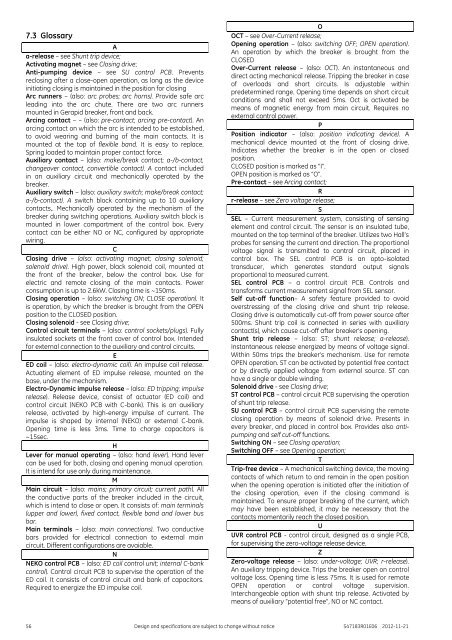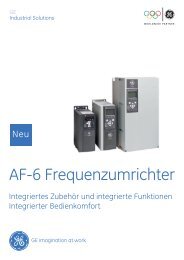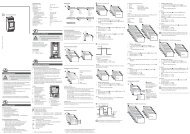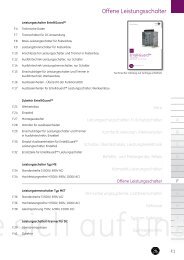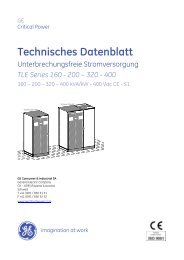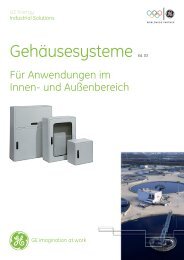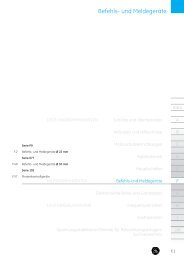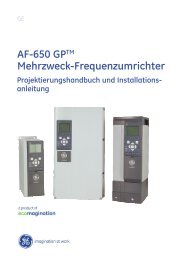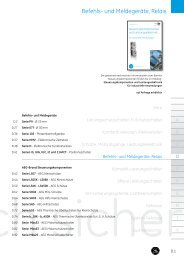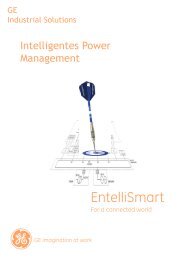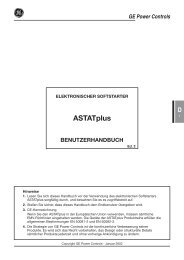GE Consumer & Industrial - G E Power Controls
GE Consumer & Industrial - G E Power Controls
GE Consumer & Industrial - G E Power Controls
Create successful ePaper yourself
Turn your PDF publications into a flip-book with our unique Google optimized e-Paper software.
7.3 Glossary<br />
A<br />
a-release – see Shunt trip device;<br />
Activating magnet – see Closing drive;<br />
Anti-pumping device – see SU control PCB. Prevents<br />
reclosing after a close-open operation, as long as the device<br />
initiating closing is maintained in the position for closing<br />
Arc runners – (also: arc probes; arc horns). Provide safe arc<br />
leading into the arc chute. There are two arc runners<br />
mounted in Gerapid breaker, front and back.<br />
Arcing contact – – (also: pre-contact; arcing pre-contact). An<br />
arcing contact on which the arc is intended to be established,<br />
to avoid wearing and burning of the main contacts. It is<br />
mounted at the top of flexible band. It is easy to replace.<br />
Spring loaded to maintain proper contact force.<br />
Auxiliary contact – (also: make/break contact; a-/b-contact,<br />
changeover contact, convertible contact). A contact included<br />
in an auxiliary circuit and mechanically operated by the<br />
breaker.<br />
Auxiliary switch – (also: auxiliary switch; make/break contact;<br />
a-/b-contact). A switch block containing up to 10 auxiliary<br />
contacts,. Mechanically operated by the mechanism of the<br />
breaker during switching operations. Auxiliary switch block is<br />
mounted in lower compartment of the control box. Every<br />
contact can be either NO or NC, configured by appropriate<br />
wiring.<br />
C<br />
Closing drive – (also: activating magnet; closing solenoid;<br />
solenoid drive). High power, black solenoid coil, mounted at<br />
the front of the breaker, below the control box. Use for<br />
electric and remote closing of the main contacts. <strong>Power</strong><br />
consumption is up to 2.6kW. Closing time is ~150ms.<br />
Closing operation – (also: switching ON; CLOSE operation). It<br />
is operation, by which the breaker is brought from the OPEN<br />
position to the CLOSED position.<br />
Closing solenoid - see Closing drive;<br />
Control circuit terminals – (also: control sockets/plugs). Fully<br />
insulated sockets at the front cover of control box. Intended<br />
for external connection to the auxiliary and control circuits.<br />
E<br />
ED coil – (also: electro-dynamic coil). An impulse coil release.<br />
Actuating element of ED impulse release, mounted on the<br />
base, under the mechanism.<br />
Electro-Dynamic impulse release – (also: ED tripping; impulse<br />
release). Release device, consist of actuator (ED coil) and<br />
control circuit (NEKO PCB with C-bank). This is an auxiliary<br />
release, activated by high-energy impulse of current. The<br />
impulse is shaped by internal (NEKO) or external C-bank.<br />
Opening time is less 3ms. Time to charge capacitors is<br />
~15sec.<br />
H<br />
Lever for manual operating – (also: hand lever). Hand lever<br />
can be used for both, closing and opening manual operation.<br />
It is intend for use only during maintenance.<br />
M<br />
Main circuit – (also: mains; primary circuit; current path). All<br />
the conductive parts of the breaker included in the circuit,<br />
which is intend to close or open. It consists of: main terminals<br />
(upper and lower), fixed contact, flexible band and lower bus<br />
bar.<br />
Main terminals – (also: main connections). Two conductive<br />
bars provided for electrical connection to external main<br />
circuit. Different configurations are avaiable.<br />
N<br />
NEKO control PCB – (also: ED coil control unit; internal C-bank<br />
control). Control circuit PCB to supervise the operation of the<br />
ED coil. It consists of control circuit and bank of capacitors.<br />
Required to energize the ED impulse coil.<br />
O<br />
OCT – see Over-Current release;<br />
Opening operation – (also: switching OFF; OPEN operation).<br />
An operation by which the breaker is brought from the<br />
CLOSED<br />
Over-Current release – (also: OCT). An instantaneous and<br />
direct acting mechanical release. Tripping the breaker in case<br />
of overloads and short circuits. Is adjustable within<br />
predetermined range. Opening time depends on short circuit<br />
conditions and shall not exceed 5ms. Oct is activated be<br />
means of magnetic energy from main circuit. Requires no<br />
external control power.<br />
P<br />
Position indicator – (also: position indicating device). A<br />
mechanical device mounted at the front of closing drive.<br />
Indicates whether the breaker is in the open or closed<br />
position.<br />
CLOSED position is marked as “I”.<br />
OPEN position is marked as “O”.<br />
Pre-contact – see Arcing contact;<br />
R<br />
r-release – see Zero voltage release;<br />
S<br />
SEL – Current measurement system, consisting of sensing<br />
element and control circuit. The sensor is an insulated tube,<br />
mounted on the top terminal of the breaker. Utilizes two Hall’s<br />
probes for sensing the current and direction. The proportional<br />
voltage signal is transmitted to control circuit, placed in<br />
control box. The SEL control PCB is an opto-isolated<br />
transducer, which generates standard output signals<br />
proportional to measured current.<br />
SEL control PCB – a control circuit PCB. <strong>Controls</strong> and<br />
transforms current measurement signal from SEL sensor.<br />
Self cut-off function– A safety feature provided to avoid<br />
overstressing of the closing drive and shunt trip release.<br />
Closing drive is automatically cut-off from power source after<br />
500ms. Shunt trip coil is connected in series with auxiliary<br />
contact(s), which cause cut-off after breaker’s opening.<br />
Shunt trip release – (also: ST; shunt release; a-release).<br />
Instantaneous release energized by means of voltage signal.<br />
Within 50ms trips the breaker’s mechanism. Use for remote<br />
OPEN operation. ST can be activated by potential free contact<br />
or by directly applied voltage from external source. ST can<br />
have a single or double winding.<br />
Solenoid drive - see Closing drive;<br />
ST control PCB – control circuit PCB supervising the operation<br />
of shunt trip release.<br />
SU control PCB – control circuit PCB supervising the remote<br />
closing operation by means of solenoid drive. Presents in<br />
every breaker, and placed in control box. Provides also antipumping<br />
and self cut-off functions.<br />
Switching ON – see Closing operation;<br />
Switching OFF – see Opening operation;<br />
T<br />
Trip-free device – A mechanical switching device, the moving<br />
contacts of which return to and remain in the open position<br />
when the opening operation is initiated after the initiation of<br />
the closing operation, even if the closing command is<br />
maintained. To ensure proper breaking of the current, which<br />
may have been established, it may be necessary that the<br />
contacts momentarily reach the closed position.<br />
U<br />
UVR control PCB - control circuit, designed as a single PCB,<br />
for supervising the zero-voltage release device.<br />
Z<br />
Zero-voltage release – (also: under-voltage; UVR; r-release).<br />
An auxiliary tripping device. Trips the breaker open on control<br />
voltage loss. Opening time is less 75ms. It is used for remote<br />
OPEN operation or control voltage supervision.<br />
Interchangeable option with shunt trip release. Activated by<br />
means of auxiliary “potential free”, NO or NC contact.<br />
56 Design and specifications are subject to change without notice S47183R01E06 2012-11-21


